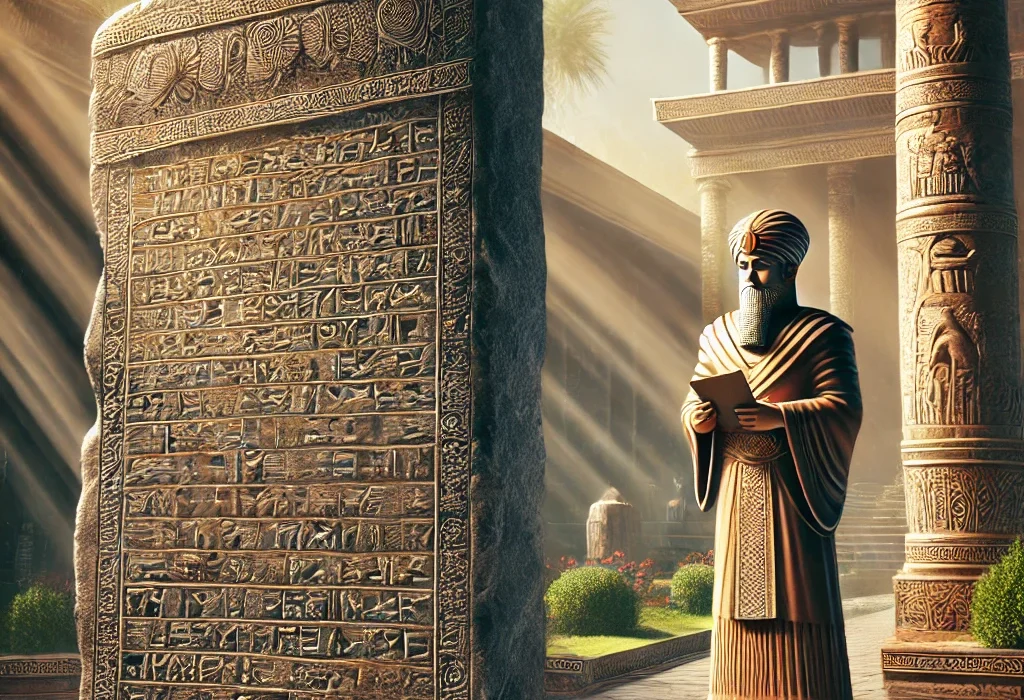The Code of Hammurabi is one of the earliest and most complete written legal codes, composed by Hammurabi, the sixth king of Babylon, around 1790 BCE. This set of 282 laws provides a glimpse into the governance, social structure, and justice system of ancient Mesopotamia. Hammurabi’s code aimed to ensure justice and prevent the oppression of the weak by the strong. The document is notable for its severe penalties and class-based distinctions in justice. Hammurabi portrayed himself as a divine ruler who brought order and justice to his empire.
Plot Summary
The Code of Hammurabi, a monumental stele inscribed with one of the earliest and most comprehensive legal codes, stands as a testament to the judicial and administrative prowess of Hammurabi, the sixth king of Babylon. Crafted around 1754 BC, this code was designed to regulate the various facets of life in ancient Mesopotamia, ensuring justice and order within Hammurabi’s vast empire. The laws cover a broad spectrum of societal issues, ranging from criminal justice and property rights to family law and trade regulations.
The prologue sets the stage with Hammurabi declaring his divine mandate to rule and administer justice, a responsibility bestowed upon him by the gods Anu and Bel. He emphasizes his role as a shepherd to his people, appointed to maintain order and fairness, and to ensure that the strong do not oppress the weak. This divine endorsement underscores the sacred nature of the laws and the king’s duty to uphold them.
The laws themselves begin with issues of personal conduct and criminal justice. Accusations of witchcraft, a significant concern in ancient societies, are addressed with strict procedures. If a man accuses another of casting a spell on him but cannot prove it, the accused must undergo an ordeal by water. This trial involves the accused plunging into the sacred river; if they survive, they are deemed innocent, and the accuser is put to death. This process underscores the high stakes of false accusations and the reliance on divine judgment in the absence of concrete evidence.
False witness in both criminal and civil cases is treated with severe penalties. In capital cases, a false witness faces death, reflecting the immense value placed on truth and the grave consequences of bearing false testimony. In civil cases, the penalty is financial, requiring the false witness to pay the damages caused by their deceit. This distinction highlights the varying levels of severity associated with different types of legal disputes.
Theft and property crimes are dealt with harshly. Stealing from a temple or house results in death for both the thief and the receiver of stolen goods, emphasizing the sanctity of religious and personal property. Similarly, kidnapping and harboring runaway slaves are capital offenses, illustrating the importance of maintaining social order and protecting individual rights. If a man buys goods from a minor or slave without proper authority, he is deemed a thief and sentenced to death, ensuring that all transactions are conducted transparently and legally.
Family law is another critical area addressed by the code. Marriages are regulated to ensure fairness and stability. For example, if a man takes a second wife but neglects the first, the first wife has the right to return to her father’s house, ensuring her protection and support. Adultery is punished by binding and throwing the adulterous couple into water, a severe penalty reflecting the serious breach of marital trust and social norms. Inheritance laws ensure that children and spouses are adequately provided for, maintaining familial continuity and stability. Sons are favored in inheritance, but provisions are made to support daughters and wives, reflecting a structured approach to family dynamics.
The code also covers agricultural practices and property management extensively. Tenants are held accountable for maintaining fields and ensuring productive harvests. If a tenant neglects the land, they must compensate the owner with average rent and restore the land to its original condition. This accountability ensures that agricultural productivity is maintained and that landowners’ interests are protected. In cases where natural disasters destroy crops, the loss is shared between the landlord and tenant, recognizing the shared risks in agricultural ventures.
Labor laws protect workers and outline their responsibilities. Artisans, builders, and other laborers are held to high standards of performance. For example, if a builder constructs a house that collapses and causes death, the builder’s life is forfeit, reflecting the high level of accountability and the importance of skill and diligence in labor. This principle extends to various professions, ensuring that workers perform their duties with care and competence.
The code includes specific regulations for merchants and trade, emphasizing the importance of fair and legal transactions. If a merchant lends money and the borrower cannot repay, the borrower must sell goods to cover the debt, ensuring that financial obligations are met. Detailed rules govern the sale and purchase of property, including requirements for witnesses to validate transactions, thereby preventing fraud and ensuring transparency.
Officials and administrators are also subject to strict laws. Governors, prefects, and other officials must perform their duties with integrity and fairness. Misappropriation of resources or failure to perform duties often results in severe penalties, including death, ensuring that public officials adhere to high standards of conduct and accountability. This rigorous approach to governance helps maintain administrative efficiency and prevents corruption.
The epilogue of the code reaffirms Hammurabi’s achievements and his divine support. He extols his role in bringing justice and prosperity to his people, invoking blessings for future rulers who uphold his laws and curses for those who disregard them. This section emphasizes the lasting impact of his legal framework and its intended perpetuation through successive generations. Hammurabi describes himself as a righteous king who has provided safe pastures for his people, cut off enemies, and ensured the well-being of his subjects. He calls upon future rulers to respect his laws and to maintain justice in the land.
In conclusion, the Code of Hammurabi stands as a remarkable legal document, reflecting the complexities of ancient Babylonian society and the king’s commitment to justice and order. Its comprehensive nature and detailed regulations provide a fascinating glimpse into the values and principles that governed one of the earliest civilizations. The code’s emphasis on divine justice, retributive measures, social hierarchy, and property rights reveals a society deeply concerned with maintaining order, fairness, and accountability.
Main Characters
Hammurabi: The central figure, Hammurabi, is the king of Babylon and the author of this legal code. He presents himself as a shepherd chosen by the gods to provide justice, protect the weak, and establish order in his kingdom. His reign and the code he created were seen as divinely inspired and central to the unification of Mesopotamian law.
The Gods (Anu, Bel, Marduk): In the prologue, Hammurabi emphasizes his relationship with the gods, particularly Anu (the supreme god), Bel (lord of heaven and earth), and Marduk (Babylon’s chief deity). These gods play a significant role in Hammurabi’s claim to divine authority, blessing him with the responsibility of ruling and delivering justice to the people.
Theme
Justice and Retribution: The principle of lex talionis (an eye for an eye) is central to Hammurabi’s laws. The code enforces strict penalties for crimes, emphasizing retributive justice to maintain social order. However, punishments vary based on social status, demonstrating a stratified legal system.
Social Hierarchy and Class Distinctions: The code clearly distinguishes between the rights and responsibilities of different social classes—patricians, plebeians, and slaves. Crimes against higher-status individuals often resulted in harsher penalties, while punishments for offenses against lower-status individuals were more lenient.
Divine Authority and Kingship: The prologue and epilogue of the code highlight Hammurabi’s belief that his authority to rule and deliver justice comes directly from the gods. His relationship with deities like Marduk legitimizes his laws as divine will.
Property and Commerce: Many of the laws concern property rights, trade, and debt, reflecting the commercial nature of Babylonian society. Regulations about ownership, contracts, and financial obligations are prevalent, ensuring that commerce could thrive under a stable legal system.
Writing Style and Tone
The Code of Hammurabi is written in a formal, declarative style that reflects the gravitas of a king issuing laws to his people. The tone is authoritative and rooted in the concept of divine kingship. The legal text itself is stark and formulaic, characteristic of early law codes, with its “if… then…” structure establishing clear cause-and-effect relationships between offenses and punishments.
In contrast, the prologue and epilogue are more literary and ceremonial, filled with flowery descriptions of Hammurabi’s relationship with the gods, his divine mission to bring justice, and his efforts to protect his people. These sections not only frame the legal content but also serve to exalt Hammurabi as a god-chosen ruler, combining the practical legal directives with a tone of royal propaganda.
We hope this summary has sparked your interest and would appreciate you following Celsius 233 on social media:
There’s a treasure trove of other fascinating book summaries waiting for you. Check out our collection of stories that inspire, thrill, and provoke thought, just like this one by checking out the Book Shelf or the Library
Remember, while our summaries capture the essence, they can never replace the full experience of reading the book. If this summary intrigued you, consider diving into the complete story – buy the book and immerse yourself in the author’s original work.
If you want to request a book summary, click here.
When Saurabh is not working/watching football/reading books/traveling, you can reach him via Twitter/X, LinkedIn, or Threads
Restart reading!








